ARCH7227: Villa Barbaro - Palladian Architecture, Design & History
VerifiedAdded on 2023/06/03
|21
|5853
|411
Essay
AI Summary
This essay delves into the history and architectural significance of Villa Barbaro, designed by Andrea Palladio. It examines the villa's design principles, including its economical materials, dramatic exterior motifs, and internal balance, all within the context of 16th-century Venetian society. The essay discusses Palladio's innovative use of materials like brick and stucco, his adaptation of Greek architectural elements, and the villa's integration with its surrounding landscape. It also touches upon the interior design, highlighting the use of frescos as a cost-effective alternative to tapestries. Drawing from the course ARCH7227 History of Housing the essay explores how Palladio addressed the need for magnificent yet functional residences in the countryside, ultimately creating a lasting architectural legacy. Desklib offers a variety of resources for students, including similar essays and study tools.
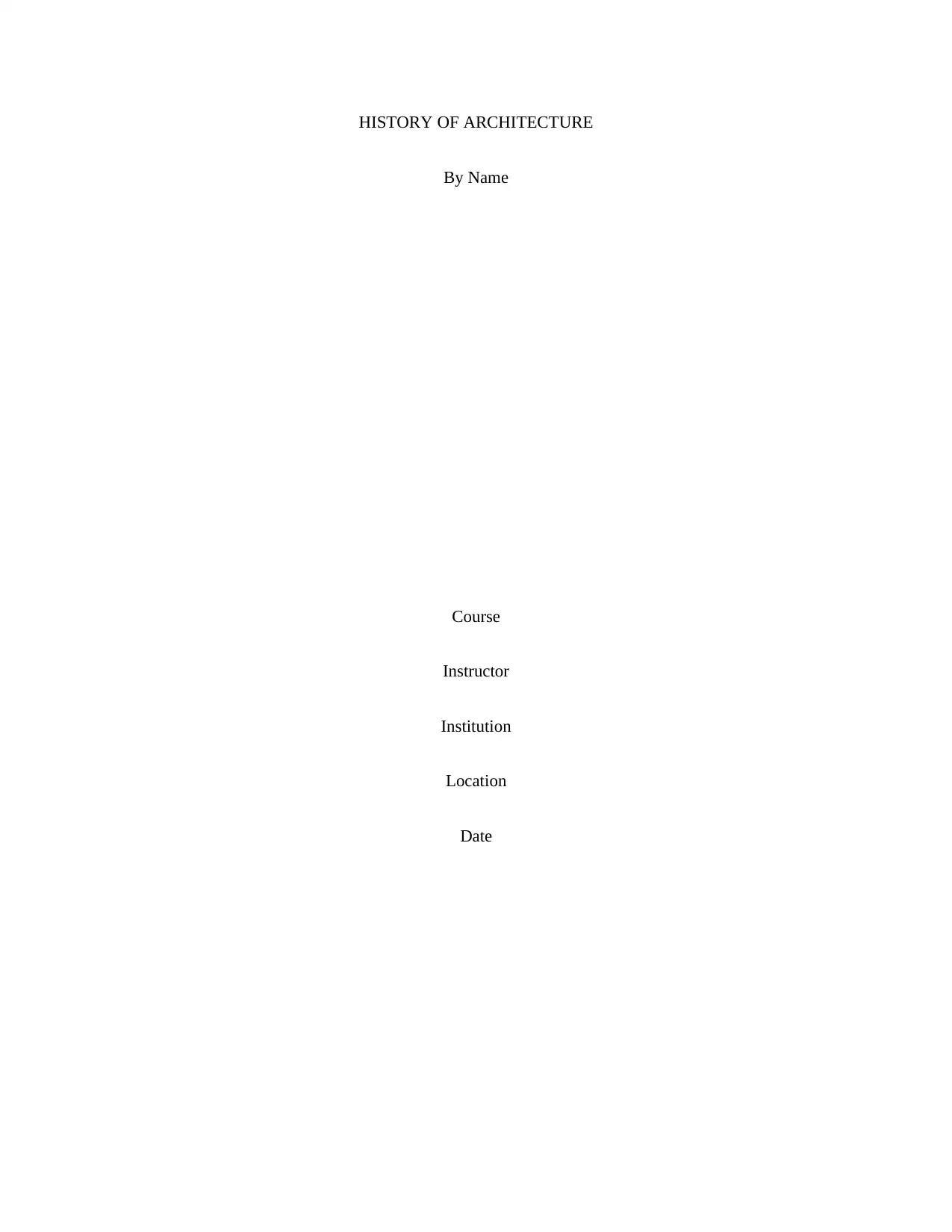
HISTORY OF ARCHITECTURE
By Name
Course
Instructor
Institution
Location
Date
By Name
Course
Instructor
Institution
Location
Date
Paraphrase This Document
Need a fresh take? Get an instant paraphrase of this document with our AI Paraphraser
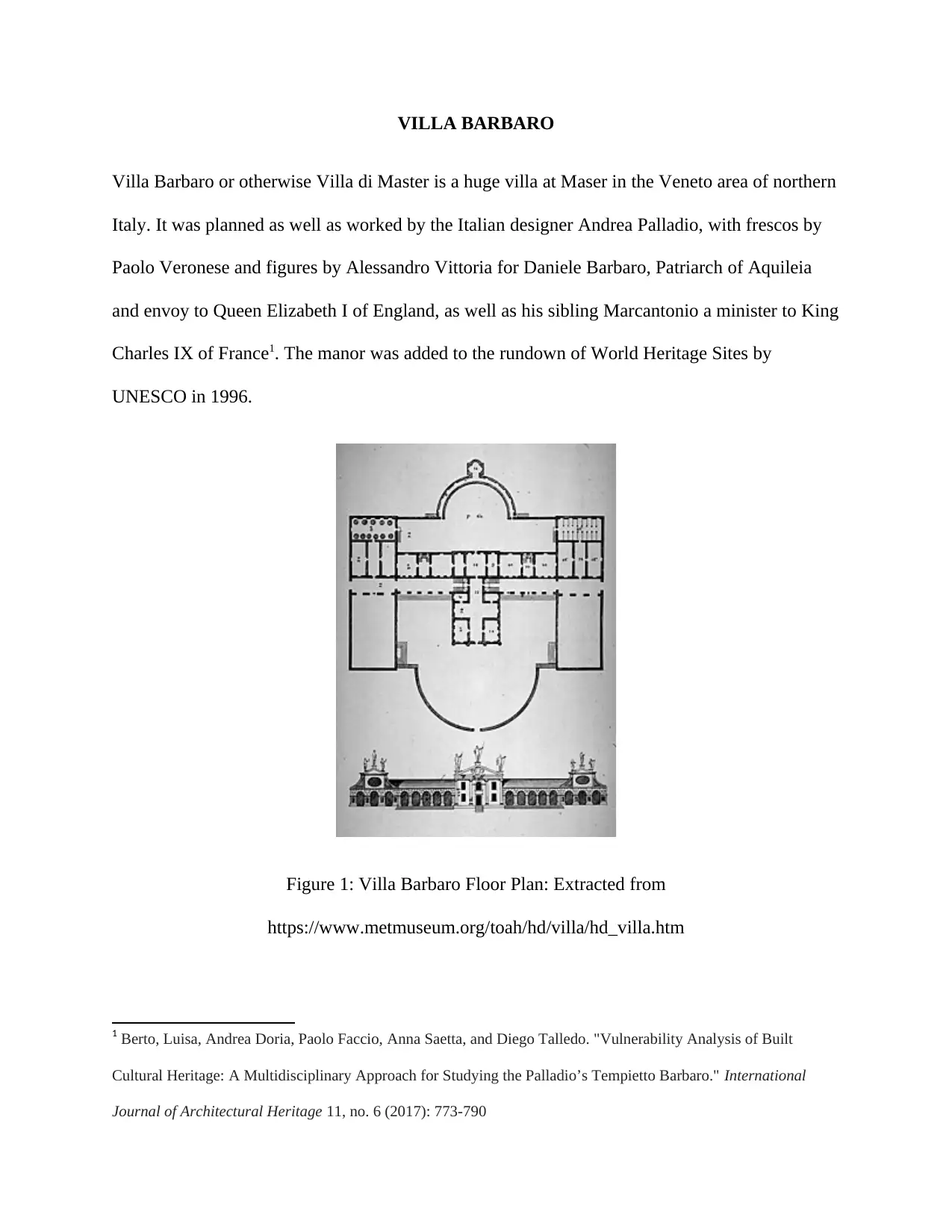
VILLA BARBARO
Villa Barbaro or otherwise Villa di Master is a huge villa at Maser in the Veneto area of northern
Italy. It was planned as well as worked by the Italian designer Andrea Palladio, with frescos by
Paolo Veronese and figures by Alessandro Vittoria for Daniele Barbaro, Patriarch of Aquileia
and envoy to Queen Elizabeth I of England, as well as his sibling Marcantonio a minister to King
Charles IX of France1. The manor was added to the rundown of World Heritage Sites by
UNESCO in 1996.
Figure 1: Villa Barbaro Floor Plan: Extracted from
https://www.metmuseum.org/toah/hd/villa/hd_villa.htm
1 Berto, Luisa, Andrea Doria, Paolo Faccio, Anna Saetta, and Diego Talledo. "Vulnerability Analysis of Built
Cultural Heritage: A Multidisciplinary Approach for Studying the Palladio’s Tempietto Barbaro." International
Journal of Architectural Heritage 11, no. 6 (2017): 773-790
Villa Barbaro or otherwise Villa di Master is a huge villa at Maser in the Veneto area of northern
Italy. It was planned as well as worked by the Italian designer Andrea Palladio, with frescos by
Paolo Veronese and figures by Alessandro Vittoria for Daniele Barbaro, Patriarch of Aquileia
and envoy to Queen Elizabeth I of England, as well as his sibling Marcantonio a minister to King
Charles IX of France1. The manor was added to the rundown of World Heritage Sites by
UNESCO in 1996.
Figure 1: Villa Barbaro Floor Plan: Extracted from
https://www.metmuseum.org/toah/hd/villa/hd_villa.htm
1 Berto, Luisa, Andrea Doria, Paolo Faccio, Anna Saetta, and Diego Talledo. "Vulnerability Analysis of Built
Cultural Heritage: A Multidisciplinary Approach for Studying the Palladio’s Tempietto Barbaro." International
Journal of Architectural Heritage 11, no. 6 (2017): 773-790
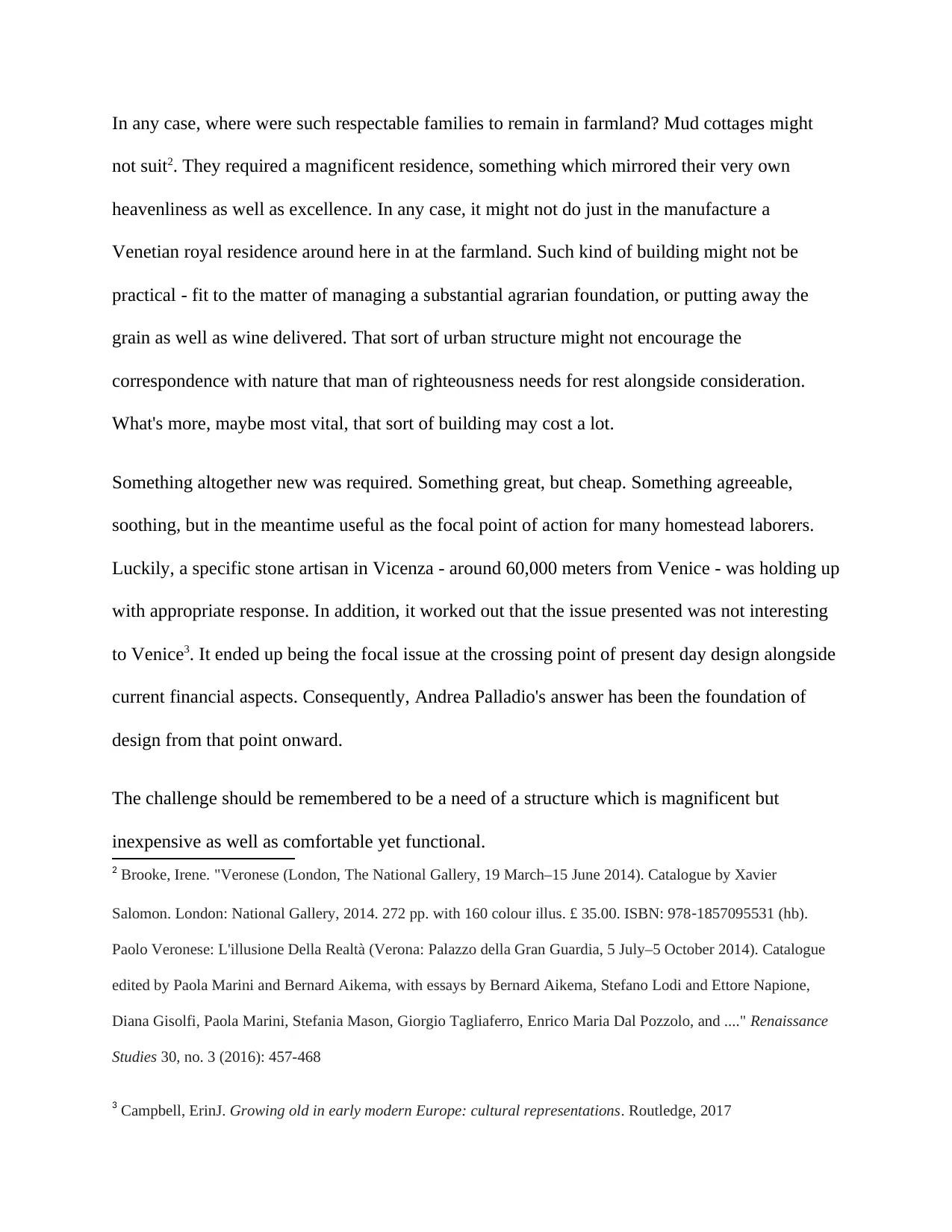
In any case, where were such respectable families to remain in farmland? Mud cottages might
not suit2. They required a magnificent residence, something which mirrored their very own
heavenliness as well as excellence. In any case, it might not do just in the manufacture a
Venetian royal residence around here in at the farmland. Such kind of building might not be
practical - fit to the matter of managing a substantial agrarian foundation, or putting away the
grain as well as wine delivered. That sort of urban structure might not encourage the
correspondence with nature that man of righteousness needs for rest alongside consideration.
What's more, maybe most vital, that sort of building may cost a lot.
Something altogether new was required. Something great, but cheap. Something agreeable,
soothing, but in the meantime useful as the focal point of action for many homestead laborers.
Luckily, a specific stone artisan in Vicenza - around 60,000 meters from Venice - was holding up
with appropriate response. In addition, it worked out that the issue presented was not interesting
to Venice3. It ended up being the focal issue at the crossing point of present day design alongside
current financial aspects. Consequently, Andrea Palladio's answer has been the foundation of
design from that point onward.
The challenge should be remembered to be a need of a structure which is magnificent but
inexpensive as well as comfortable yet functional.
2 Brooke, Irene. "Veronese (London, The National Gallery, 19 March–15 June 2014). Catalogue by Xavier
Salomon. London: National Gallery, 2014. 272 pp. with 160 colour illus. £ 35.00. ISBN: 978‐1857095531 (hb).
Paolo Veronese: L'illusione Della Realtà (Verona: Palazzo della Gran Guardia, 5 July–5 October 2014). Catalogue
edited by Paola Marini and Bernard Aikema, with essays by Bernard Aikema, Stefano Lodi and Ettore Napione,
Diana Gisolfi, Paola Marini, Stefania Mason, Giorgio Tagliaferro, Enrico Maria Dal Pozzolo, and ...." Renaissance
Studies 30, no. 3 (2016): 457-468
3 Campbell, ErinJ. Growing old in early modern Europe: cultural representations. Routledge, 2017
not suit2. They required a magnificent residence, something which mirrored their very own
heavenliness as well as excellence. In any case, it might not do just in the manufacture a
Venetian royal residence around here in at the farmland. Such kind of building might not be
practical - fit to the matter of managing a substantial agrarian foundation, or putting away the
grain as well as wine delivered. That sort of urban structure might not encourage the
correspondence with nature that man of righteousness needs for rest alongside consideration.
What's more, maybe most vital, that sort of building may cost a lot.
Something altogether new was required. Something great, but cheap. Something agreeable,
soothing, but in the meantime useful as the focal point of action for many homestead laborers.
Luckily, a specific stone artisan in Vicenza - around 60,000 meters from Venice - was holding up
with appropriate response. In addition, it worked out that the issue presented was not interesting
to Venice3. It ended up being the focal issue at the crossing point of present day design alongside
current financial aspects. Consequently, Andrea Palladio's answer has been the foundation of
design from that point onward.
The challenge should be remembered to be a need of a structure which is magnificent but
inexpensive as well as comfortable yet functional.
2 Brooke, Irene. "Veronese (London, The National Gallery, 19 March–15 June 2014). Catalogue by Xavier
Salomon. London: National Gallery, 2014. 272 pp. with 160 colour illus. £ 35.00. ISBN: 978‐1857095531 (hb).
Paolo Veronese: L'illusione Della Realtà (Verona: Palazzo della Gran Guardia, 5 July–5 October 2014). Catalogue
edited by Paola Marini and Bernard Aikema, with essays by Bernard Aikema, Stefano Lodi and Ettore Napione,
Diana Gisolfi, Paola Marini, Stefania Mason, Giorgio Tagliaferro, Enrico Maria Dal Pozzolo, and ...." Renaissance
Studies 30, no. 3 (2016): 457-468
3 Campbell, ErinJ. Growing old in early modern Europe: cultural representations. Routledge, 2017
⊘ This is a preview!⊘
Do you want full access?
Subscribe today to unlock all pages.

Trusted by 1+ million students worldwide
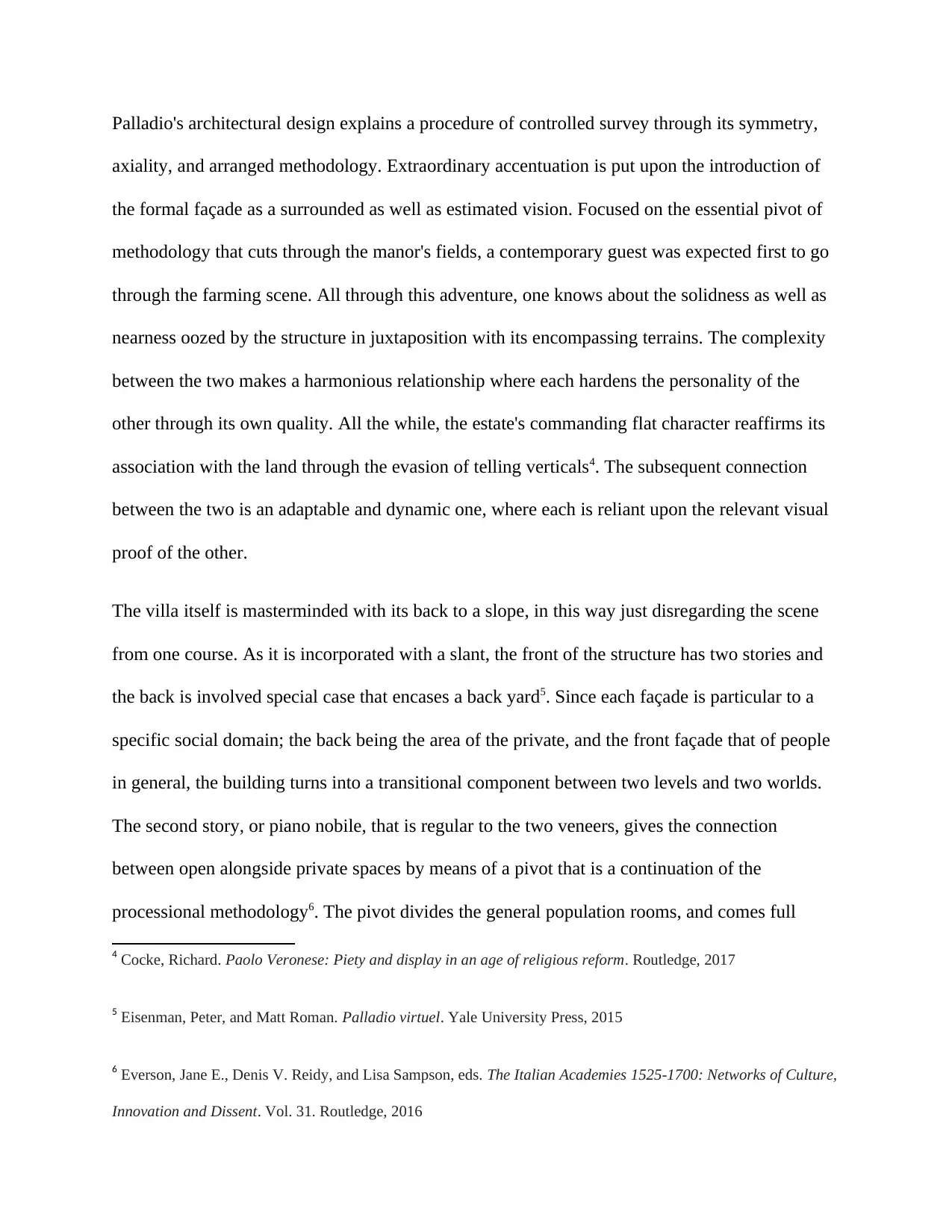
Palladio's architectural design explains a procedure of controlled survey through its symmetry,
axiality, and arranged methodology. Extraordinary accentuation is put upon the introduction of
the formal façade as a surrounded as well as estimated vision. Focused on the essential pivot of
methodology that cuts through the manor's fields, a contemporary guest was expected first to go
through the farming scene. All through this adventure, one knows about the solidness as well as
nearness oozed by the structure in juxtaposition with its encompassing terrains. The complexity
between the two makes a harmonious relationship where each hardens the personality of the
other through its own quality. All the while, the estate's commanding flat character reaffirms its
association with the land through the evasion of telling verticals4. The subsequent connection
between the two is an adaptable and dynamic one, where each is reliant upon the relevant visual
proof of the other.
The villa itself is masterminded with its back to a slope, in this way just disregarding the scene
from one course. As it is incorporated with a slant, the front of the structure has two stories and
the back is involved special case that encases a back yard5. Since each façade is particular to a
specific social domain; the back being the area of the private, and the front façade that of people
in general, the building turns into a transitional component between two levels and two worlds.
The second story, or piano nobile, that is regular to the two veneers, gives the connection
between open alongside private spaces by means of a pivot that is a continuation of the
processional methodology6. The pivot divides the general population rooms, and comes full
4 Cocke, Richard. Paolo Veronese: Piety and display in an age of religious reform. Routledge, 2017
5 Eisenman, Peter, and Matt Roman. Palladio virtuel. Yale University Press, 2015
6 Everson, Jane E., Denis V. Reidy, and Lisa Sampson, eds. The Italian Academies 1525-1700: Networks of Culture,
Innovation and Dissent. Vol. 31. Routledge, 2016
axiality, and arranged methodology. Extraordinary accentuation is put upon the introduction of
the formal façade as a surrounded as well as estimated vision. Focused on the essential pivot of
methodology that cuts through the manor's fields, a contemporary guest was expected first to go
through the farming scene. All through this adventure, one knows about the solidness as well as
nearness oozed by the structure in juxtaposition with its encompassing terrains. The complexity
between the two makes a harmonious relationship where each hardens the personality of the
other through its own quality. All the while, the estate's commanding flat character reaffirms its
association with the land through the evasion of telling verticals4. The subsequent connection
between the two is an adaptable and dynamic one, where each is reliant upon the relevant visual
proof of the other.
The villa itself is masterminded with its back to a slope, in this way just disregarding the scene
from one course. As it is incorporated with a slant, the front of the structure has two stories and
the back is involved special case that encases a back yard5. Since each façade is particular to a
specific social domain; the back being the area of the private, and the front façade that of people
in general, the building turns into a transitional component between two levels and two worlds.
The second story, or piano nobile, that is regular to the two veneers, gives the connection
between open alongside private spaces by means of a pivot that is a continuation of the
processional methodology6. The pivot divides the general population rooms, and comes full
4 Cocke, Richard. Paolo Veronese: Piety and display in an age of religious reform. Routledge, 2017
5 Eisenman, Peter, and Matt Roman. Palladio virtuel. Yale University Press, 2015
6 Everson, Jane E., Denis V. Reidy, and Lisa Sampson, eds. The Italian Academies 1525-1700: Networks of Culture,
Innovation and Dissent. Vol. 31. Routledge, 2016
Paraphrase This Document
Need a fresh take? Get an instant paraphrase of this document with our AI Paraphraser
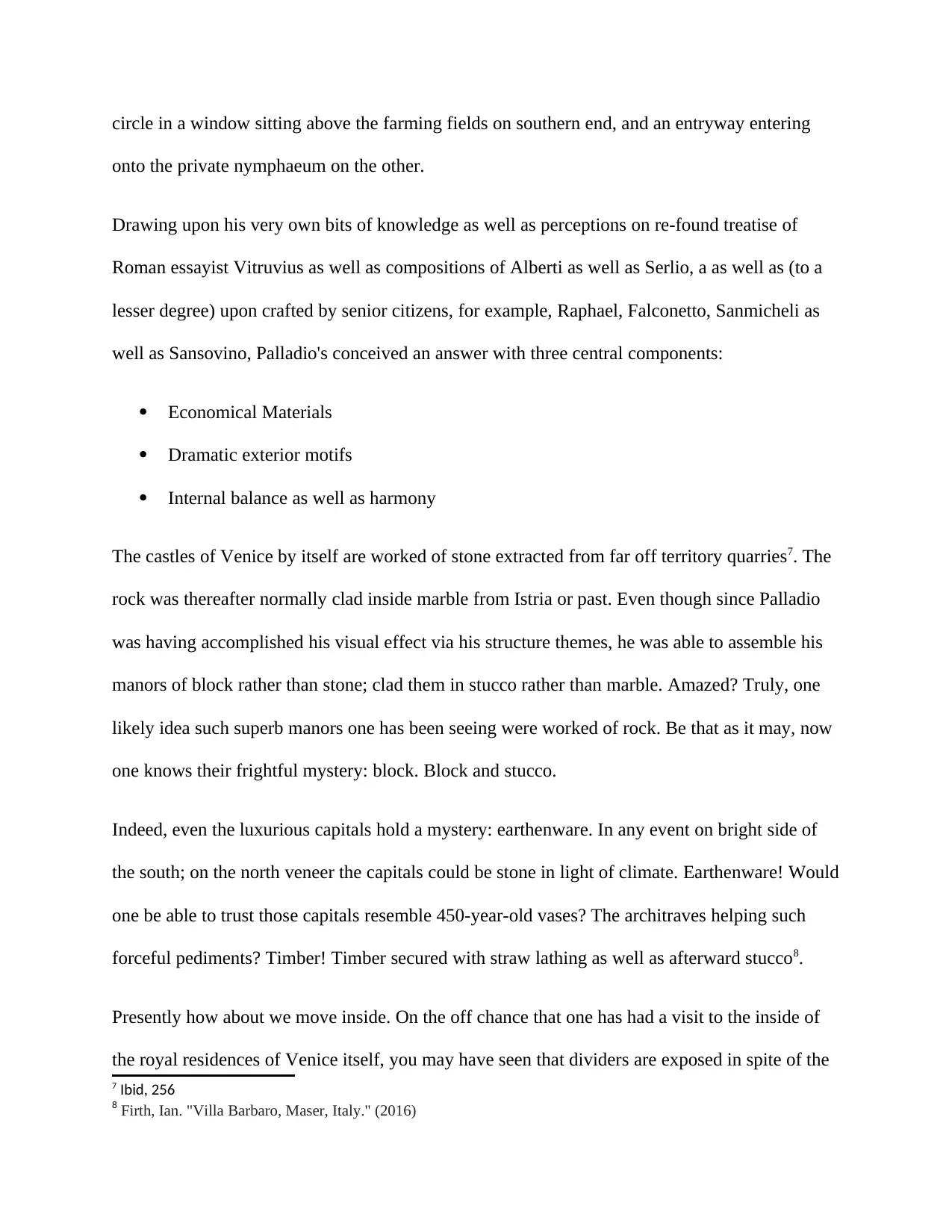
circle in a window sitting above the farming fields on southern end, and an entryway entering
onto the private nymphaeum on the other.
Drawing upon his very own bits of knowledge as well as perceptions on re-found treatise of
Roman essayist Vitruvius as well as compositions of Alberti as well as Serlio, a as well as (to a
lesser degree) upon crafted by senior citizens, for example, Raphael, Falconetto, Sanmicheli as
well as Sansovino, Palladio's conceived an answer with three central components:
Economical Materials
Dramatic exterior motifs
Internal balance as well as harmony
The castles of Venice by itself are worked of stone extracted from far off territory quarries7. The
rock was thereafter normally clad inside marble from Istria or past. Even though since Palladio
was having accomplished his visual effect via his structure themes, he was able to assemble his
manors of block rather than stone; clad them in stucco rather than marble. Amazed? Truly, one
likely idea such superb manors one has been seeing were worked of rock. Be that as it may, now
one knows their frightful mystery: block. Block and stucco.
Indeed, even the luxurious capitals hold a mystery: earthenware. In any event on bright side of
the south; on the north veneer the capitals could be stone in light of climate. Earthenware! Would
one be able to trust those capitals resemble 450-year-old vases? The architraves helping such
forceful pediments? Timber! Timber secured with straw lathing as well as afterward stucco8.
Presently how about we move inside. On the off chance that one has had a visit to the inside of
the royal residences of Venice itself, you may have seen that dividers are exposed in spite of the
7 Ibid, 256
8 Firth, Ian. "Villa Barbaro, Maser, Italy." (2016)
onto the private nymphaeum on the other.
Drawing upon his very own bits of knowledge as well as perceptions on re-found treatise of
Roman essayist Vitruvius as well as compositions of Alberti as well as Serlio, a as well as (to a
lesser degree) upon crafted by senior citizens, for example, Raphael, Falconetto, Sanmicheli as
well as Sansovino, Palladio's conceived an answer with three central components:
Economical Materials
Dramatic exterior motifs
Internal balance as well as harmony
The castles of Venice by itself are worked of stone extracted from far off territory quarries7. The
rock was thereafter normally clad inside marble from Istria or past. Even though since Palladio
was having accomplished his visual effect via his structure themes, he was able to assemble his
manors of block rather than stone; clad them in stucco rather than marble. Amazed? Truly, one
likely idea such superb manors one has been seeing were worked of rock. Be that as it may, now
one knows their frightful mystery: block. Block and stucco.
Indeed, even the luxurious capitals hold a mystery: earthenware. In any event on bright side of
the south; on the north veneer the capitals could be stone in light of climate. Earthenware! Would
one be able to trust those capitals resemble 450-year-old vases? The architraves helping such
forceful pediments? Timber! Timber secured with straw lathing as well as afterward stucco8.
Presently how about we move inside. On the off chance that one has had a visit to the inside of
the royal residences of Venice itself, you may have seen that dividers are exposed in spite of the
7 Ibid, 256
8 Firth, Ian. "Villa Barbaro, Maser, Italy." (2016)
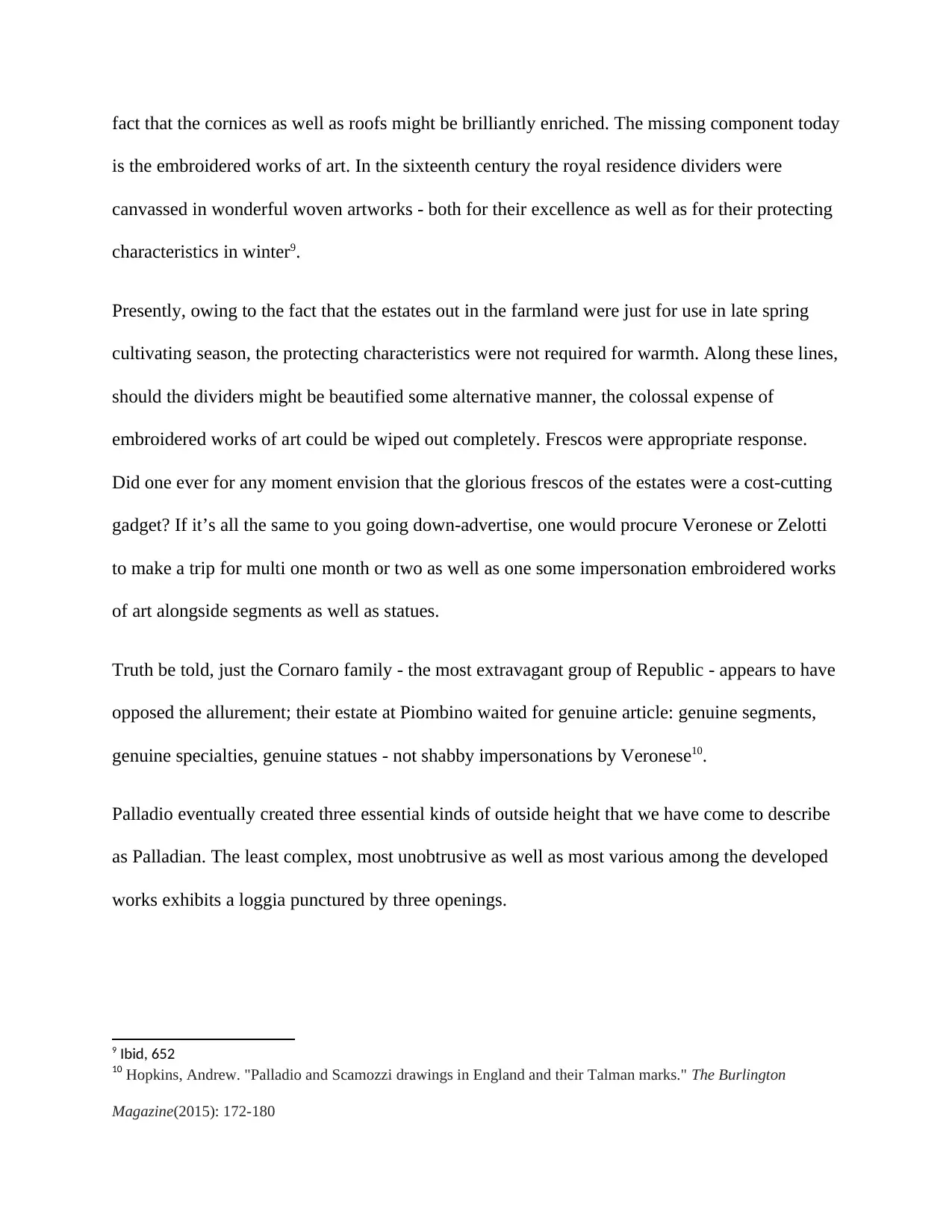
fact that the cornices as well as roofs might be brilliantly enriched. The missing component today
is the embroidered works of art. In the sixteenth century the royal residence dividers were
canvassed in wonderful woven artworks - both for their excellence as well as for their protecting
characteristics in winter9.
Presently, owing to the fact that the estates out in the farmland were just for use in late spring
cultivating season, the protecting characteristics were not required for warmth. Along these lines,
should the dividers might be beautified some alternative manner, the colossal expense of
embroidered works of art could be wiped out completely. Frescos were appropriate response.
Did one ever for any moment envision that the glorious frescos of the estates were a cost-cutting
gadget? If it’s all the same to you going down-advertise, one would procure Veronese or Zelotti
to make a trip for multi one month or two as well as one some impersonation embroidered works
of art alongside segments as well as statues.
Truth be told, just the Cornaro family - the most extravagant group of Republic - appears to have
opposed the allurement; their estate at Piombino waited for genuine article: genuine segments,
genuine specialties, genuine statues - not shabby impersonations by Veronese10.
Palladio eventually created three essential kinds of outside height that we have come to describe
as Palladian. The least complex, most unobtrusive as well as most various among the developed
works exhibits a loggia punctured by three openings.
9 Ibid, 652
10 Hopkins, Andrew. "Palladio and Scamozzi drawings in England and their Talman marks." The Burlington
Magazine(2015): 172-180
is the embroidered works of art. In the sixteenth century the royal residence dividers were
canvassed in wonderful woven artworks - both for their excellence as well as for their protecting
characteristics in winter9.
Presently, owing to the fact that the estates out in the farmland were just for use in late spring
cultivating season, the protecting characteristics were not required for warmth. Along these lines,
should the dividers might be beautified some alternative manner, the colossal expense of
embroidered works of art could be wiped out completely. Frescos were appropriate response.
Did one ever for any moment envision that the glorious frescos of the estates were a cost-cutting
gadget? If it’s all the same to you going down-advertise, one would procure Veronese or Zelotti
to make a trip for multi one month or two as well as one some impersonation embroidered works
of art alongside segments as well as statues.
Truth be told, just the Cornaro family - the most extravagant group of Republic - appears to have
opposed the allurement; their estate at Piombino waited for genuine article: genuine segments,
genuine specialties, genuine statues - not shabby impersonations by Veronese10.
Palladio eventually created three essential kinds of outside height that we have come to describe
as Palladian. The least complex, most unobtrusive as well as most various among the developed
works exhibits a loggia punctured by three openings.
9 Ibid, 652
10 Hopkins, Andrew. "Palladio and Scamozzi drawings in England and their Talman marks." The Burlington
Magazine(2015): 172-180
⊘ This is a preview!⊘
Do you want full access?
Subscribe today to unlock all pages.

Trusted by 1+ million students worldwide
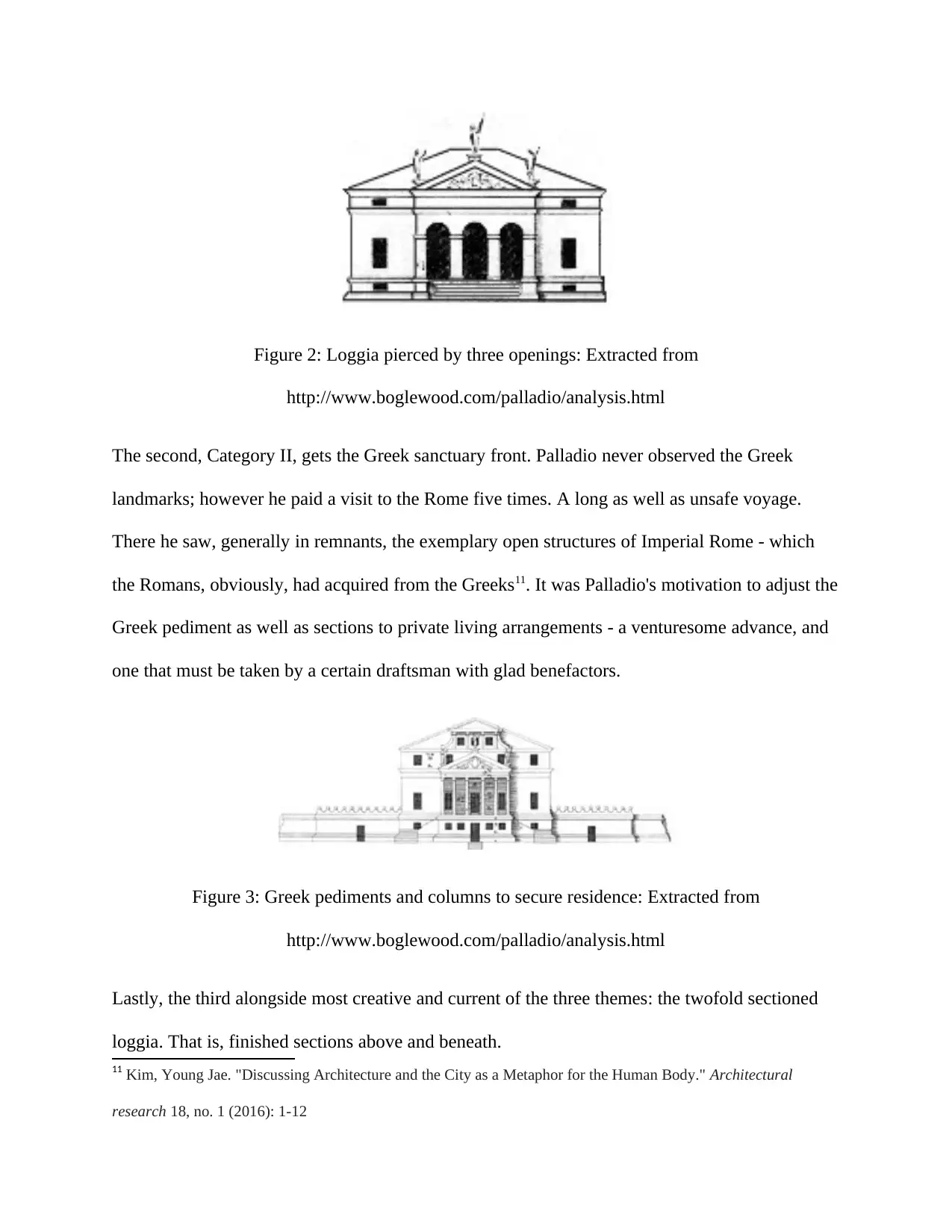
Figure 2: Loggia pierced by three openings: Extracted from
http://www.boglewood.com/palladio/analysis.html
The second, Category II, gets the Greek sanctuary front. Palladio never observed the Greek
landmarks; however he paid a visit to the Rome five times. A long as well as unsafe voyage.
There he saw, generally in remnants, the exemplary open structures of Imperial Rome - which
the Romans, obviously, had acquired from the Greeks11. It was Palladio's motivation to adjust the
Greek pediment as well as sections to private living arrangements - a venturesome advance, and
one that must be taken by a certain draftsman with glad benefactors.
Figure 3: Greek pediments and columns to secure residence: Extracted from
http://www.boglewood.com/palladio/analysis.html
Lastly, the third alongside most creative and current of the three themes: the twofold sectioned
loggia. That is, finished sections above and beneath.
11 Kim, Young Jae. "Discussing Architecture and the City as a Metaphor for the Human Body." Architectural
research 18, no. 1 (2016): 1-12
http://www.boglewood.com/palladio/analysis.html
The second, Category II, gets the Greek sanctuary front. Palladio never observed the Greek
landmarks; however he paid a visit to the Rome five times. A long as well as unsafe voyage.
There he saw, generally in remnants, the exemplary open structures of Imperial Rome - which
the Romans, obviously, had acquired from the Greeks11. It was Palladio's motivation to adjust the
Greek pediment as well as sections to private living arrangements - a venturesome advance, and
one that must be taken by a certain draftsman with glad benefactors.
Figure 3: Greek pediments and columns to secure residence: Extracted from
http://www.boglewood.com/palladio/analysis.html
Lastly, the third alongside most creative and current of the three themes: the twofold sectioned
loggia. That is, finished sections above and beneath.
11 Kim, Young Jae. "Discussing Architecture and the City as a Metaphor for the Human Body." Architectural
research 18, no. 1 (2016): 1-12
Paraphrase This Document
Need a fresh take? Get an instant paraphrase of this document with our AI Paraphraser
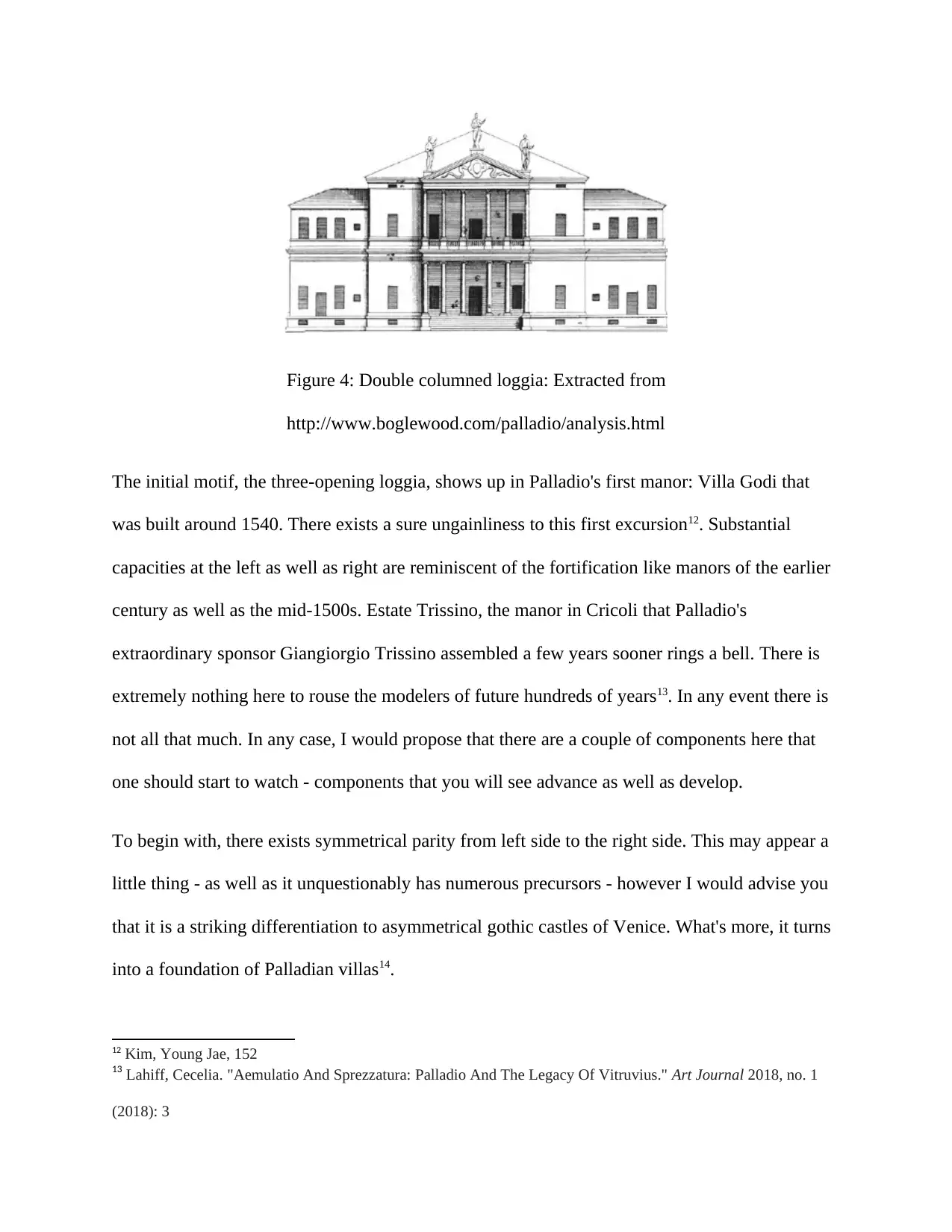
Figure 4: Double columned loggia: Extracted from
http://www.boglewood.com/palladio/analysis.html
The initial motif, the three-opening loggia, shows up in Palladio's first manor: Villa Godi that
was built around 1540. There exists a sure ungainliness to this first excursion12. Substantial
capacities at the left as well as right are reminiscent of the fortification like manors of the earlier
century as well as the mid-1500s. Estate Trissino, the manor in Cricoli that Palladio's
extraordinary sponsor Giangiorgio Trissino assembled a few years sooner rings a bell. There is
extremely nothing here to rouse the modelers of future hundreds of years13. In any event there is
not all that much. In any case, I would propose that there are a couple of components here that
one should start to watch - components that you will see advance as well as develop.
To begin with, there exists symmetrical parity from left side to the right side. This may appear a
little thing - as well as it unquestionably has numerous precursors - however I would advise you
that it is a striking differentiation to asymmetrical gothic castles of Venice. What's more, it turns
into a foundation of Palladian villas14.
12 Kim, Young Jae, 152
13 Lahiff, Cecelia. "Aemulatio And Sprezzatura: Palladio And The Legacy Of Vitruvius." Art Journal 2018, no. 1
(2018): 3
http://www.boglewood.com/palladio/analysis.html
The initial motif, the three-opening loggia, shows up in Palladio's first manor: Villa Godi that
was built around 1540. There exists a sure ungainliness to this first excursion12. Substantial
capacities at the left as well as right are reminiscent of the fortification like manors of the earlier
century as well as the mid-1500s. Estate Trissino, the manor in Cricoli that Palladio's
extraordinary sponsor Giangiorgio Trissino assembled a few years sooner rings a bell. There is
extremely nothing here to rouse the modelers of future hundreds of years13. In any event there is
not all that much. In any case, I would propose that there are a couple of components here that
one should start to watch - components that you will see advance as well as develop.
To begin with, there exists symmetrical parity from left side to the right side. This may appear a
little thing - as well as it unquestionably has numerous precursors - however I would advise you
that it is a striking differentiation to asymmetrical gothic castles of Venice. What's more, it turns
into a foundation of Palladian villas14.
12 Kim, Young Jae, 152
13 Lahiff, Cecelia. "Aemulatio And Sprezzatura: Palladio And The Legacy Of Vitruvius." Art Journal 2018, no. 1
(2018): 3
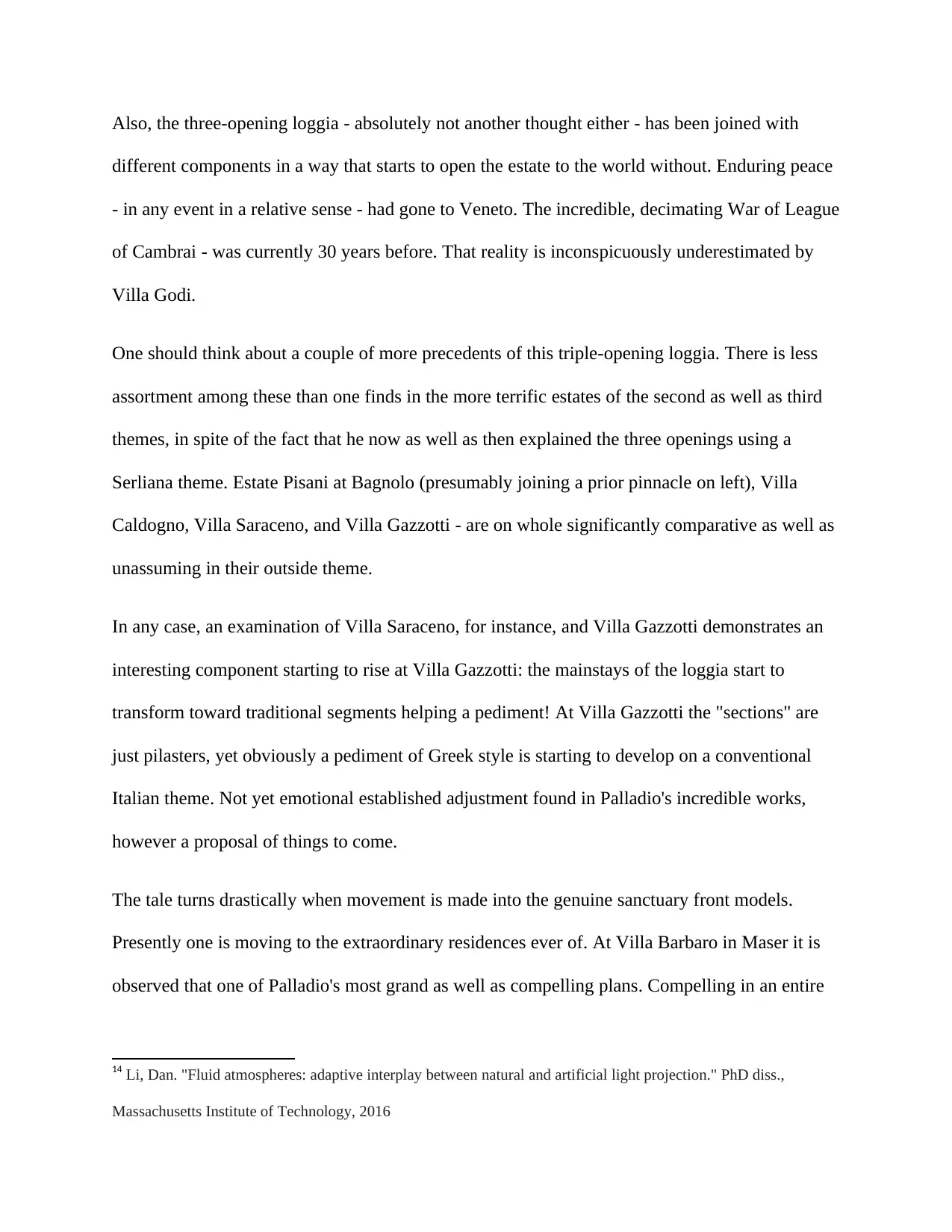
Also, the three-opening loggia - absolutely not another thought either - has been joined with
different components in a way that starts to open the estate to the world without. Enduring peace
- in any event in a relative sense - had gone to Veneto. The incredible, decimating War of League
of Cambrai - was currently 30 years before. That reality is inconspicuously underestimated by
Villa Godi.
One should think about a couple of more precedents of this triple-opening loggia. There is less
assortment among these than one finds in the more terrific estates of the second as well as third
themes, in spite of the fact that he now as well as then explained the three openings using a
Serliana theme. Estate Pisani at Bagnolo (presumably joining a prior pinnacle on left), Villa
Caldogno, Villa Saraceno, and Villa Gazzotti - are on whole significantly comparative as well as
unassuming in their outside theme.
In any case, an examination of Villa Saraceno, for instance, and Villa Gazzotti demonstrates an
interesting component starting to rise at Villa Gazzotti: the mainstays of the loggia start to
transform toward traditional segments helping a pediment! At Villa Gazzotti the "sections" are
just pilasters, yet obviously a pediment of Greek style is starting to develop on a conventional
Italian theme. Not yet emotional established adjustment found in Palladio's incredible works,
however a proposal of things to come.
The tale turns drastically when movement is made into the genuine sanctuary front models.
Presently one is moving to the extraordinary residences ever of. At Villa Barbaro in Maser it is
observed that one of Palladio's most grand as well as compelling plans. Compelling in an entire
14 Li, Dan. "Fluid atmospheres: adaptive interplay between natural and artificial light projection." PhD diss.,
Massachusetts Institute of Technology, 2016
different components in a way that starts to open the estate to the world without. Enduring peace
- in any event in a relative sense - had gone to Veneto. The incredible, decimating War of League
of Cambrai - was currently 30 years before. That reality is inconspicuously underestimated by
Villa Godi.
One should think about a couple of more precedents of this triple-opening loggia. There is less
assortment among these than one finds in the more terrific estates of the second as well as third
themes, in spite of the fact that he now as well as then explained the three openings using a
Serliana theme. Estate Pisani at Bagnolo (presumably joining a prior pinnacle on left), Villa
Caldogno, Villa Saraceno, and Villa Gazzotti - are on whole significantly comparative as well as
unassuming in their outside theme.
In any case, an examination of Villa Saraceno, for instance, and Villa Gazzotti demonstrates an
interesting component starting to rise at Villa Gazzotti: the mainstays of the loggia start to
transform toward traditional segments helping a pediment! At Villa Gazzotti the "sections" are
just pilasters, yet obviously a pediment of Greek style is starting to develop on a conventional
Italian theme. Not yet emotional established adjustment found in Palladio's incredible works,
however a proposal of things to come.
The tale turns drastically when movement is made into the genuine sanctuary front models.
Presently one is moving to the extraordinary residences ever of. At Villa Barbaro in Maser it is
observed that one of Palladio's most grand as well as compelling plans. Compelling in an entire
14 Li, Dan. "Fluid atmospheres: adaptive interplay between natural and artificial light projection." PhD diss.,
Massachusetts Institute of Technology, 2016
⊘ This is a preview!⊘
Do you want full access?
Subscribe today to unlock all pages.

Trusted by 1+ million students worldwide
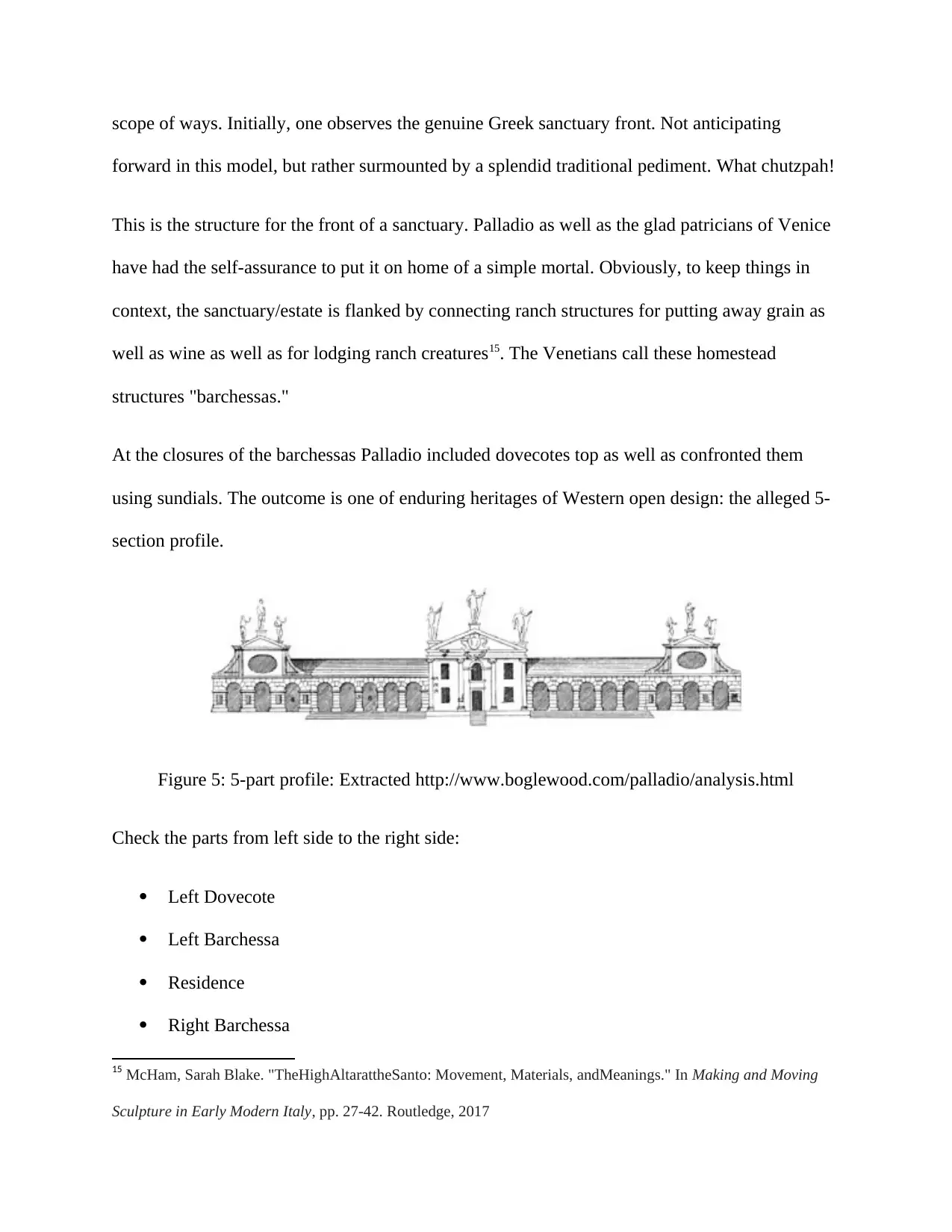
scope of ways. Initially, one observes the genuine Greek sanctuary front. Not anticipating
forward in this model, but rather surmounted by a splendid traditional pediment. What chutzpah!
This is the structure for the front of a sanctuary. Palladio as well as the glad patricians of Venice
have had the self-assurance to put it on home of a simple mortal. Obviously, to keep things in
context, the sanctuary/estate is flanked by connecting ranch structures for putting away grain as
well as wine as well as for lodging ranch creatures15. The Venetians call these homestead
structures "barchessas."
At the closures of the barchessas Palladio included dovecotes top as well as confronted them
using sundials. The outcome is one of enduring heritages of Western open design: the alleged 5-
section profile.
Figure 5: 5-part profile: Extracted http://www.boglewood.com/palladio/analysis.html
Check the parts from left side to the right side:
Left Dovecote
Left Barchessa
Residence
Right Barchessa
15 McHam, Sarah Blake. "TheHighAltarattheSanto: Movement, Materials, andMeanings." In Making and Moving
Sculpture in Early Modern Italy, pp. 27-42. Routledge, 2017
forward in this model, but rather surmounted by a splendid traditional pediment. What chutzpah!
This is the structure for the front of a sanctuary. Palladio as well as the glad patricians of Venice
have had the self-assurance to put it on home of a simple mortal. Obviously, to keep things in
context, the sanctuary/estate is flanked by connecting ranch structures for putting away grain as
well as wine as well as for lodging ranch creatures15. The Venetians call these homestead
structures "barchessas."
At the closures of the barchessas Palladio included dovecotes top as well as confronted them
using sundials. The outcome is one of enduring heritages of Western open design: the alleged 5-
section profile.
Figure 5: 5-part profile: Extracted http://www.boglewood.com/palladio/analysis.html
Check the parts from left side to the right side:
Left Dovecote
Left Barchessa
Residence
Right Barchessa
15 McHam, Sarah Blake. "TheHighAltarattheSanto: Movement, Materials, andMeanings." In Making and Moving
Sculpture in Early Modern Italy, pp. 27-42. Routledge, 2017
Paraphrase This Document
Need a fresh take? Get an instant paraphrase of this document with our AI Paraphraser
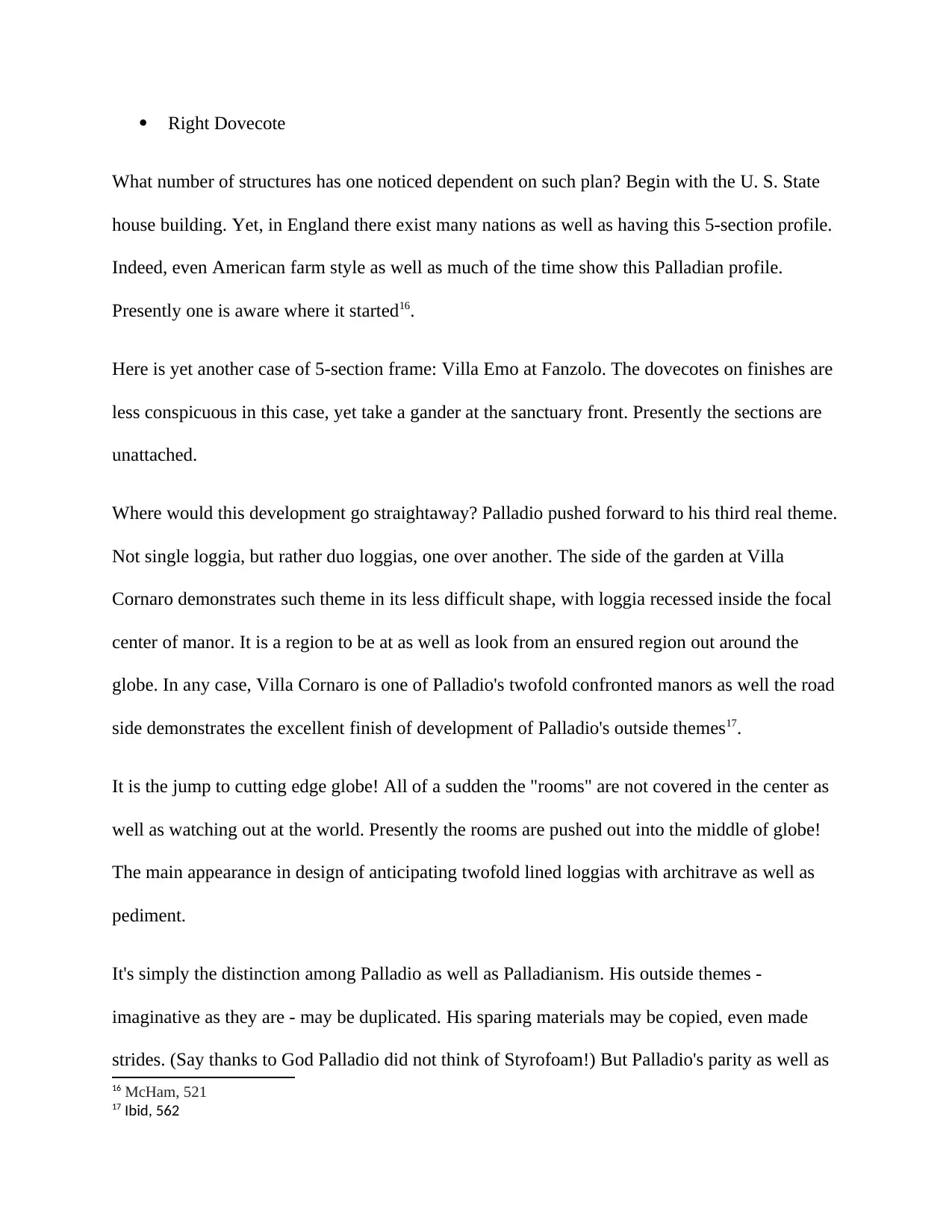
Right Dovecote
What number of structures has one noticed dependent on such plan? Begin with the U. S. State
house building. Yet, in England there exist many nations as well as having this 5-section profile.
Indeed, even American farm style as well as much of the time show this Palladian profile.
Presently one is aware where it started16.
Here is yet another case of 5-section frame: Villa Emo at Fanzolo. The dovecotes on finishes are
less conspicuous in this case, yet take a gander at the sanctuary front. Presently the sections are
unattached.
Where would this development go straightaway? Palladio pushed forward to his third real theme.
Not single loggia, but rather duo loggias, one over another. The side of the garden at Villa
Cornaro demonstrates such theme in its less difficult shape, with loggia recessed inside the focal
center of manor. It is a region to be at as well as look from an ensured region out around the
globe. In any case, Villa Cornaro is one of Palladio's twofold confronted manors as well the road
side demonstrates the excellent finish of development of Palladio's outside themes17.
It is the jump to cutting edge globe! All of a sudden the "rooms" are not covered in the center as
well as watching out at the world. Presently the rooms are pushed out into the middle of globe!
The main appearance in design of anticipating twofold lined loggias with architrave as well as
pediment.
It's simply the distinction among Palladio as well as Palladianism. His outside themes -
imaginative as they are - may be duplicated. His sparing materials may be copied, even made
strides. (Say thanks to God Palladio did not think of Styrofoam!) But Palladio's parity as well as
16 McHam, 521
17 Ibid, 562
What number of structures has one noticed dependent on such plan? Begin with the U. S. State
house building. Yet, in England there exist many nations as well as having this 5-section profile.
Indeed, even American farm style as well as much of the time show this Palladian profile.
Presently one is aware where it started16.
Here is yet another case of 5-section frame: Villa Emo at Fanzolo. The dovecotes on finishes are
less conspicuous in this case, yet take a gander at the sanctuary front. Presently the sections are
unattached.
Where would this development go straightaway? Palladio pushed forward to his third real theme.
Not single loggia, but rather duo loggias, one over another. The side of the garden at Villa
Cornaro demonstrates such theme in its less difficult shape, with loggia recessed inside the focal
center of manor. It is a region to be at as well as look from an ensured region out around the
globe. In any case, Villa Cornaro is one of Palladio's twofold confronted manors as well the road
side demonstrates the excellent finish of development of Palladio's outside themes17.
It is the jump to cutting edge globe! All of a sudden the "rooms" are not covered in the center as
well as watching out at the world. Presently the rooms are pushed out into the middle of globe!
The main appearance in design of anticipating twofold lined loggias with architrave as well as
pediment.
It's simply the distinction among Palladio as well as Palladianism. His outside themes -
imaginative as they are - may be duplicated. His sparing materials may be copied, even made
strides. (Say thanks to God Palladio did not think of Styrofoam!) But Palladio's parity as well as
16 McHam, 521
17 Ibid, 562
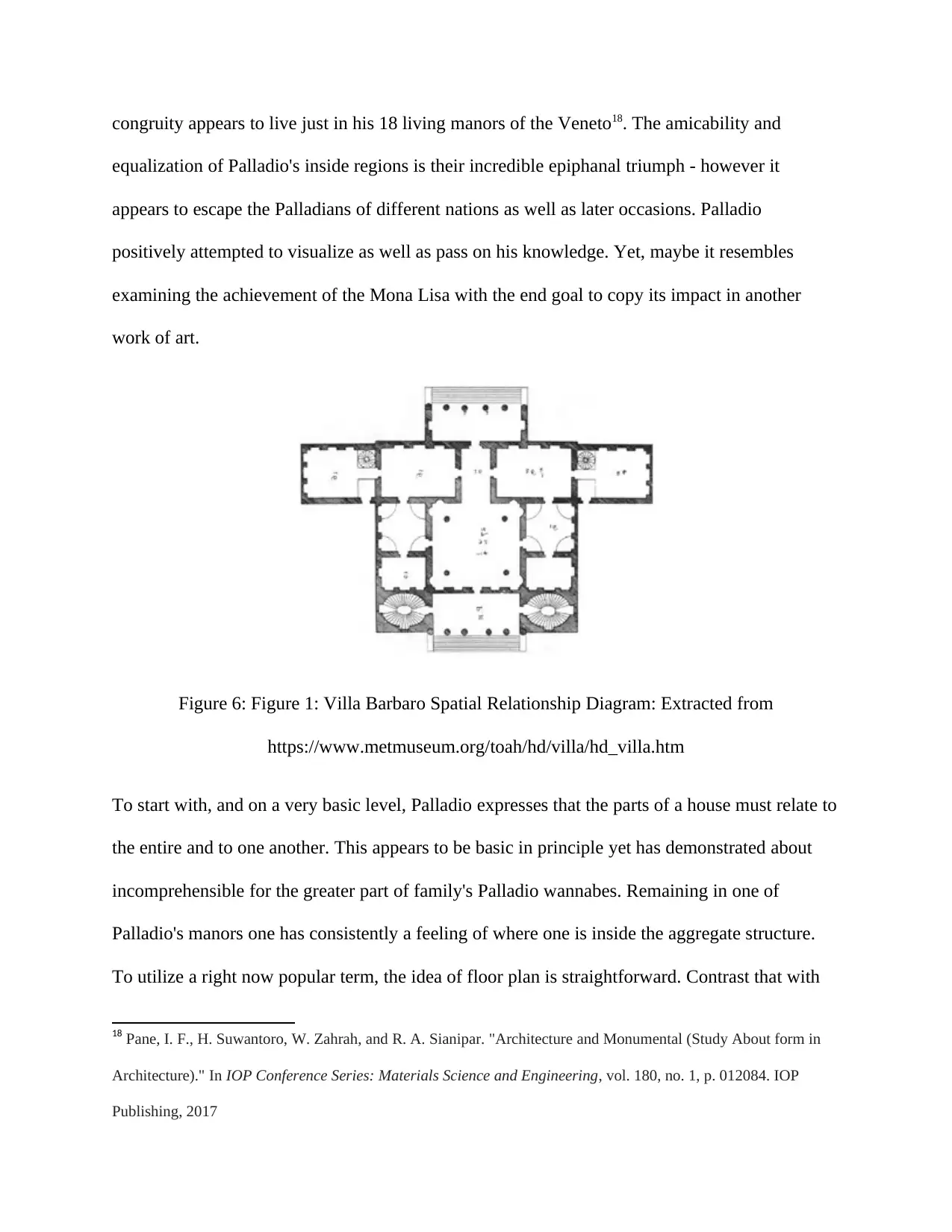
congruity appears to live just in his 18 living manors of the Veneto18. The amicability and
equalization of Palladio's inside regions is their incredible epiphanal triumph - however it
appears to escape the Palladians of different nations as well as later occasions. Palladio
positively attempted to visualize as well as pass on his knowledge. Yet, maybe it resembles
examining the achievement of the Mona Lisa with the end goal to copy its impact in another
work of art.
Figure 6: Figure 1: Villa Barbaro Spatial Relationship Diagram: Extracted from
https://www.metmuseum.org/toah/hd/villa/hd_villa.htm
To start with, and on a very basic level, Palladio expresses that the parts of a house must relate to
the entire and to one another. This appears to be basic in principle yet has demonstrated about
incomprehensible for the greater part of family's Palladio wannabes. Remaining in one of
Palladio's manors one has consistently a feeling of where one is inside the aggregate structure.
To utilize a right now popular term, the idea of floor plan is straightforward. Contrast that with
18 Pane, I. F., H. Suwantoro, W. Zahrah, and R. A. Sianipar. "Architecture and Monumental (Study About form in
Architecture)." In IOP Conference Series: Materials Science and Engineering, vol. 180, no. 1, p. 012084. IOP
Publishing, 2017
equalization of Palladio's inside regions is their incredible epiphanal triumph - however it
appears to escape the Palladians of different nations as well as later occasions. Palladio
positively attempted to visualize as well as pass on his knowledge. Yet, maybe it resembles
examining the achievement of the Mona Lisa with the end goal to copy its impact in another
work of art.
Figure 6: Figure 1: Villa Barbaro Spatial Relationship Diagram: Extracted from
https://www.metmuseum.org/toah/hd/villa/hd_villa.htm
To start with, and on a very basic level, Palladio expresses that the parts of a house must relate to
the entire and to one another. This appears to be basic in principle yet has demonstrated about
incomprehensible for the greater part of family's Palladio wannabes. Remaining in one of
Palladio's manors one has consistently a feeling of where one is inside the aggregate structure.
To utilize a right now popular term, the idea of floor plan is straightforward. Contrast that with
18 Pane, I. F., H. Suwantoro, W. Zahrah, and R. A. Sianipar. "Architecture and Monumental (Study About form in
Architecture)." In IOP Conference Series: Materials Science and Engineering, vol. 180, no. 1, p. 012084. IOP
Publishing, 2017
⊘ This is a preview!⊘
Do you want full access?
Subscribe today to unlock all pages.

Trusted by 1+ million students worldwide
1 out of 21
Your All-in-One AI-Powered Toolkit for Academic Success.
+13062052269
info@desklib.com
Available 24*7 on WhatsApp / Email
![[object Object]](/_next/static/media/star-bottom.7253800d.svg)
Unlock your academic potential
Copyright © 2020–2025 A2Z Services. All Rights Reserved. Developed and managed by ZUCOL.